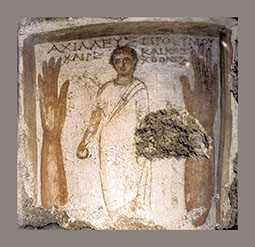Author: E.C. Portale
Download article as .pdf: Ancora sulle stele e le edicole dipinte di Lilibeo: immagini, formule, funzioni

The paper analyzes the painted funerary stelae and naiskoi from Lylibaeum (Sicily), recently increased by two new pieces. Besides typology, iconography, epigraphical formulas, also the (few) contextual data at disposal are considered, in order to highlight specificities, messages, and functions of such artifacts. Some stylistic and antiquarian cross-cutting features, in addiction to epigraphical details, show that both the simpler stelae with a standing person holding a pomegrate, and the more complex aediculae with the “Totenmahlmotiv” were made about the same time, in the Late Republican period. Their clear differences as for morphology, iconography, epigraphs and place of discovery are due to different function and context. Unlike the funerary stelae, mainly coming from the “necropoli di via del Fante” and belonging to grave markers or epitymbia, the naiskoi were found all together further north, during illicit excavantions. In the vicinity, nearer the seashore, some parts of a sacred area with niches and aediculae cut into the rock were also intercepted in 1902, and more recently in some archaeological digs, that discovered also a ditch pierced with a row of niches of cultic-funerary purpose. The former installations belonged probably to a rock sanctuary dedicated to ancestors/heroes, like some similar contexts in Sicily. The painted naiskoi, on their part, are intented to commemorate a small group of “contemporary” dead as heroes, as the title “heros/ heros agathos” and the “hero at banquet” cliché suggest; moreover, the aedicula with a offering trapeza and/or big fruits painted on its forefront alludes to a ritual of heroxenic type, imagined to be performed for the dead.
